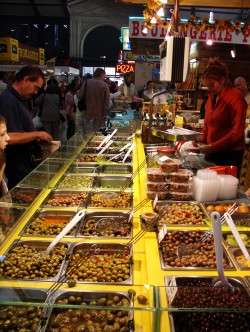All About Food | March 24th, 2016

If you travel to the big cities in America today you will come across the hottest food to trend to hit the restaurant scene since the food truck explosion of the nineties. We’ve all visited food courts at our local mall but the new trend of high end food halls is sweeping the country.
Imagine dropping into a food hall where there are booths staffed and run by the likes of Mario Batali, Marc Forgione and other hot chefs, either new on the scene or well established. This could the future of eating out in America. As we become more diverse and want more exciting tastes and flavors what better way than a food hall. Here you can eat five to six days a week and enjoy high quality food prepared fresh and at a much lower price than you would pay in their fine dining counterparts.
Not only do urban areas get the reward of great food options but these food halls are taking over empty inner city buildings and repurposing them, bringing a new vitally to the urban core and landscape. These structures, some destined for demolition like the Ponce City Market in Atlanta are driving a renaissance of reclaimed structures that then become vibrant hubs in their respective communities.
The Pensy, brainchild of caterer Mary Giuliani owner of Giuliani Social in New York City, sits on top of one of the busiest train station hubs in the world, Penn Station and next to the Madison Square Garden which needs no introduction. The 8,000 square foot food hall houses five stalls, an independent bar operation and is smack dab in the heart of Manhattan. It is busy and consequently New York City loud. Which makes the separation between food hall and food court a little gray. It is better in so many ways than a food court but lacks the subtle elegance associated with great halls.
What sets the Pensy apart is the quality of the food and the players. The obvious food court characters, Orange Julius, Domino’s Pizza and Cinnabon are absent but so is the affordability for the average Joe. It is Manhattan after all and the quality is vastly superior so you would expect to pay more. But this is not about money it is about quality which is evident in the Marc Forgione’ venture featuring lobster and aptly named the Lobster Press or The Little Beet showcasing vegetables in bowls, wraps and bento boxes. Atlanta’s Ponce City Market is on a grander scale as it is housed in a giant bygone era Sears‐Roebuck distribution center which was saved from the wreckers ball by development visionaries, Jamestown Investments, who also Chelsea Market in NYC.
This two million square foot revitalization project, which earned a historic preservation award and landed it in the National Trust for Historic Preservation, is also LEED certified showcasing so many green initiatives such as bicycle and car charging stations, recycled water usage and too many others to mention here. Centered around a food hall which houses twenty five vendors, three of which are run by James Beard Award winning chefs, the complex also has apartments, flats, offices and other retail space. This is slightly more than a just a food hall.
Food halls are not a new concept in Europe and not in America either. Three of the great food halls reside in London: Harrods, Selfridges and Fortnum & Mason (any foodie should have them on their bucket list for a visit) and not to mention the Reading Terminal in Pennsylvania which was opened in 1693 and the Grand Central Market which came into fruition in 1917. The classic food halls have food purveyors of all sorts selling their wares along with food consumables and eating areas. It has a shared purpose and they lean more towards retail sales than being strictly places to eat in the moment.
Visit the elegant chandelier draped halls of Harrods with its exquisite tile and rich marble floors, glistening glasses cases of fine confections, meats and cheeses and it is apparent there is a vast distinction between the Pensy and the old world. Over the centuries Harrods has grown to several connecting halls featuring the finest foods from England and around the world. The butcher and seafood shops with the clerks topped out in the traditional straw boater will guide up through their wares with a graciousness rarely found these days. While catching a fish thrown at you in Seattle’s Pikes Peak Market has its own allure as do the hawkers in Toronto’s St. Lawrence Market.
Eataly, conceived by Oscar Farinetti in Turin Italy, before he partnered up with none other than Mario Batali along with Joe and Lidia Bastianich is now the largest Italian food marketplace and eatery in the world. With its sixty three thousand square foot marketplace with fifteen restaurants in Chicago and twenty‐seven other locations worldwide it has brought the best of Italy to every man’s home. Along with other American marketplaces which house ‘food halls” such as The Source in Denver, Union Market in DC or Brookfield Place in NYC, visionaries with good taste are revitalizing and stimulating more than just the taste buds of urban America.
November 18th 2025
November 12th 2025
September 16th 2025
August 19th 2025
July 15th 2025
_(1)__293px-wide.png)
_(1)__293px-wide.jpg)

_(1)__293px-wide.jpg)
_(1)__293px-wide.png)
__293px-wide.jpg)